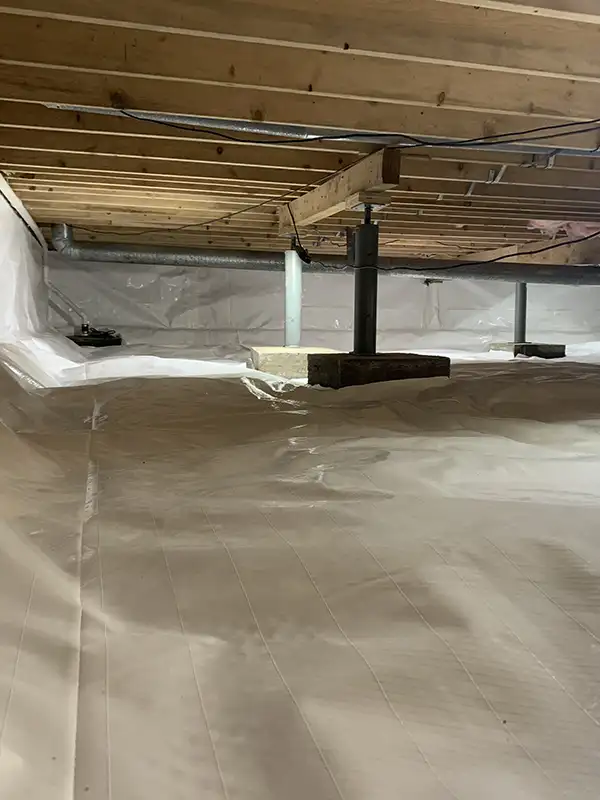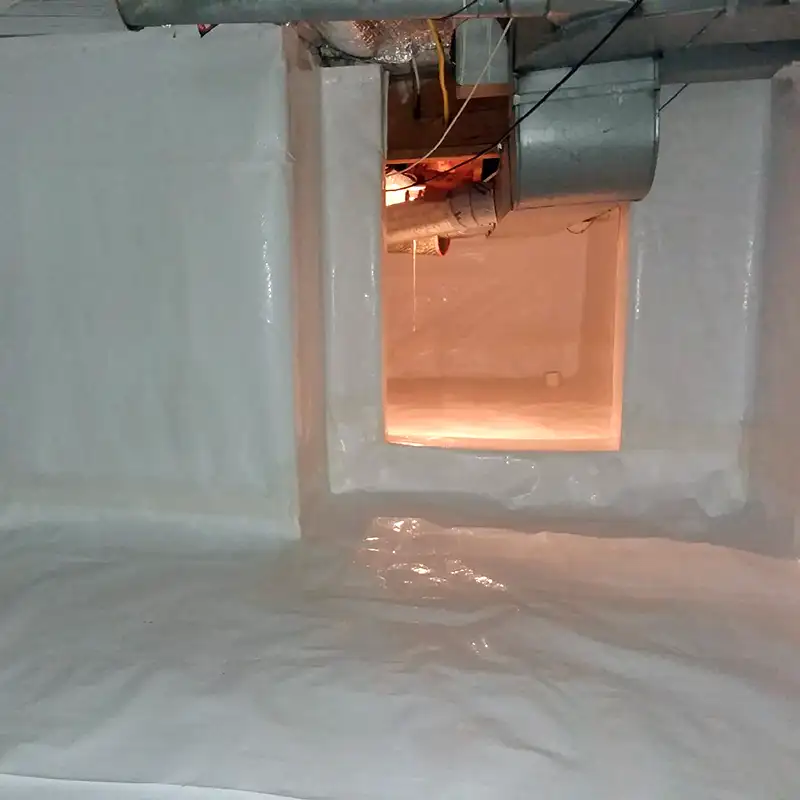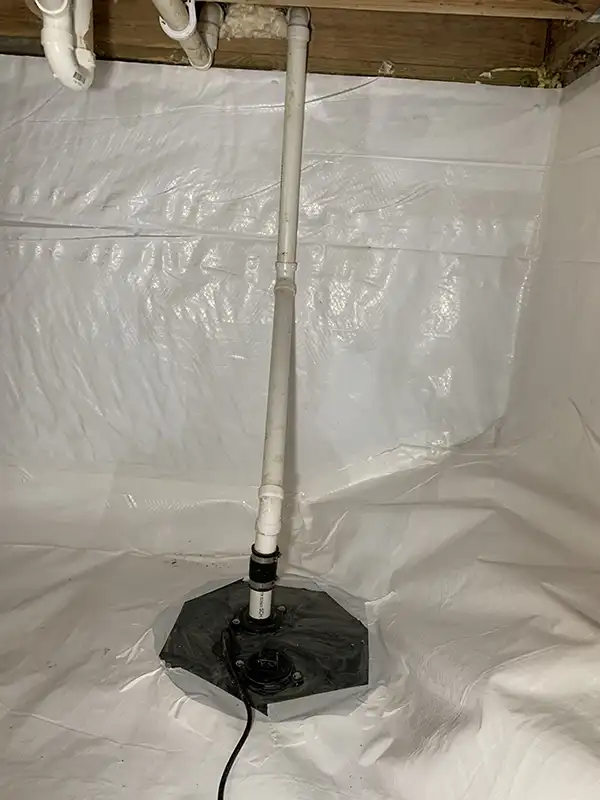Crawl Space Encapsulation

A crawl space plays a crucial role in a home’s structural integrity, air quality, and energy efficiency. Effective management involves waterproofing to prevent moisture intrusion and mold growth, encapsulation with vapor barriers for reduced energy consumption, and moisture control mechanisms like drainage systems and dehumidifiers. Proper ventilation helps regulate humidity and air movement, guaranteeing a healthier environment. Insulation reduces temperature fluctuations and condensation risks, while long-term maintenance, including regular humidity monitoring and pest inspections, guarantees durability. Detailed practices like excavation can even convert crawl spaces into usable basements, adding potential value to the property. Learn more about optimizing your crawl space.
Key Elements
Waterproofing: Prevent moisture, mold growth, and structural damage using drainage solutions, sump pumps, and sealing entry points.
Encapsulation: Seals crawl space with vapor barriers, reducing energy costs and improving air quality.
Moisture Control: Combines ventilation, vapor barriers, and drainage systems to keep humidity below 65% and prevent pest infestations.
Ventilation: Regulates humidity and air quality using active or passive airflow, maintaining stable conditions.
Long-Term Maintenance: Regularly monitor humidity, inspect for mold and pests, and maintain dehumidifiers and insulation.
Crawl Space Waterproofing
Waterproofing a crawl space is vital to prevent moisture intrusion, which can lead to mold growth, structural damage, and poor indoor air quality. Effective waterproofing begins with implementing proper drainage solutions. Confirming that water is directed away from the crawl space through adequate landscape grading and installing French drains can greatly mitigate moisture entry. These measures help maintain structural integrity by preventing water accumulation that could weaken foundation materials.
Sump pumps are another essential component in crawl space waterproofing. These devices actively remove water that may enter the crawl space, especially during heavy rainfall or flooding. By installing a reliable sump pump system, homeowners can guarantee that any water intrusion is promptly addressed, thereby reducing the risk of mold growth and water damage.
Pest prevention is also an important aspect of waterproofing. Moist environments attract pests, which can further compromise the condition of the crawl space. Sealing all potential entry points and using pest-resistant materials can help prevent infestations. This not only protects the crawl space but also maintains overall structural integrity by preventing damage from wood-destroying insects like termites.
Insulation techniques play a vital role in waterproofing a crawl space. Properly insulating the walls and floors of the crawl space helps to control temperature and humidity levels, reducing condensation and moisture buildup. This can be achieved using rigid foam boards or spray foam insulation, which also adds a layer of thermal resistance.
Regular maintenance and inspections are necessary to confirm that drainage solutions, sump pumps, and insulation remain effective. Addressing these elements thoroughly guarantees a dry, healthy, and structurally sound crawl space.
Crawl Space Encapsulation
Encapsulation involves sealing a crawl space with vapor barriers and insulation materials to control moisture, improve air quality, and enhance structural integrity. The encapsulation process begins with a thorough inspection to identify existing moisture and damage. After clearing the space of debris, a high-quality vapor barrier is installed across the floor and walls to block moisture entry. Vents and air leaks are sealed, and insulation materials are added to maintain a stable temperature. For ideal results, dehumidifiers may be installed to manage humidity levels effectively.
The benefits of crawl space encapsulation are numerous:
Energy Efficiency: By sealing and insulating the crawl space, homeowners can reduce energy consumption, leading to lower utility bills.
Pest Prevention: Sealing gaps and openings prevents pests from entering and inhabiting the crawl space.
Improved Air Quality: Encapsulation reduces mold and mildew growth, which can greatly improve indoor air quality.
Structural Integrity: Controlling moisture prevents wood rot and structural damage, preserving the home’s foundation.
However, common mistakes during encapsulation can undermine these benefits. Neglecting proper ventilation can lead to moisture buildup, and using incorrect materials, such as spray foam, can trap moisture. Additionally, failing to address existing moisture issues before encapsulation and overlooking the installation of adequate drainage systems can result in persistent problems.
For those considering encapsulation, it is crucial to engage experienced professionals who understand the technical details and best practices. Proper encapsulation not only enhances a home’s energy efficiency and air quality but also provides long-term protection against pests and structural damage. Understanding the crawl space benefits and following a meticulous encapsulation process guarantees ideal outcomes and lasting improvements.
Excavation/Basement Conversion
Transforming a crawl space into a full basement through excavation offers homeowners additional living space, enhanced property value, and improved structural support. Crawl space renovation begins with a thorough structural assessment to guarantee the existing foundation can withstand the additional load. Engineers and contractors evaluate the integrity of the current foundation and identify areas needing reinforcement or foundation repair.
Once the assessment is complete, excavation commences. This involves removing soil to achieve the desired basement depth. Careful attention is given to maintaining structural stability during this process, often requiring temporary supports. Excavation must also account for proper drainage solutions to prevent future water intrusion. Installing perimeter drains and sump pumps can effectively manage groundwater and rainwater, protecting the new basement from moisture-related issues.
After excavation, the foundation walls may need underpinning to support the increased height and weight of the structure. This step is essential for maintaining the building’s integrity, especially in older homes where foundation materials may have degraded over time. Reinforcement techniques such as adding concrete footings or steel braces guarantee long-term stability.
Pest prevention is another vital aspect of the conversion process. Sealing entry points, installing barriers, and applying treatments during construction can mitigate infestations, which are common in subterranean spaces. This proactive approach guarantees a safer, more secure living environment.
Moisture control
Effective moisture control in crawl spaces involves a combination of strategies, including proper ventilation, vapor barriers, and drainage systems, to maintain structural integrity and indoor air quality. The presence of moisture in crawl spaces can lead to a myriad of issues such as mold growth, pest infestations, and compromised structural components. Mold prevention begins with the installation of a high-quality vapor barrier across the crawl space floor and walls to block ground moisture.
Maintaining ideal humidity levels is vital. Utilizing a hygrometer to monitor and guarantee that humidity levels stay below 65% can prevent mold proliferation and preserve air quality. Dehumidifiers are often employed to regulate these levels effectively.
Implementing effective drainage solutions is necessary. Properly designed and installed drainage systems, such as French drains or sump pumps, divert water away from the foundation, thereby reducing the risk of flooding and standing water.
For thorough pest management, sealing entry points and using pest deterrents can prevent infestations that thrive in moist environments. This not only protects the building materials but also enhances the overall air quality within the home.
To summarize, important strategies for moisture control in crawl spaces include:
Vapor Barriers: Installing thick plastic sheeting to cover the crawl space floor and walls.
Humidity Control: Using hygrometers and dehumidifiers to maintain humidity levels below 65%.
Drainage Solutions: Implementing systems like French drains and sump pumps to manage water.
Pest Management: Sealing entry points and using deterrents to prevent infestations.
Ventilation
How can proper ventilation in a crawl space prevent moisture buildup and improve overall air quality? Effective ventilation is essential for maintaining a healthy crawl space environment by regulating humidity levels and promoting adequate airflow patterns. Different ventilation types, including actively vented, passively vented, and conditioned (encapsulated) spaces, offer various benefits and challenges depending on regional climate conditions and specific crawl space needs.
Actively vented crawl spaces use mechanical systems to enhance air movement, effectively reducing humidity. Passively vented spaces, on the other hand, rely on natural airflow patterns facilitated by strategically placed vents. Both methods aim to minimize moisture accumulation, which can otherwise lead to mold growth and wood rot.
Conditioned crawl spaces, or encapsulated spaces, incorporate a sealed environment with controlled ventilation to achieve ideal humidity control. This method often includes dehumidifiers and robust insulation methods, ensuring consistent moisture levels below the critical 65% threshold. Such controlled environments greatly improve overall air quality by reducing contaminants and allergens.
The humidity effects within a crawl space can be considerable, directly impacting structural integrity and indoor air quality. High humidity fosters mold growth and attracts pests like termites and rodents, necessitating rigorous pest prevention strategies. Proper ventilation mitigates these risks by maintaining a balanced environment.
Insulation methods complement ventilation efforts by reducing temperature fluctuations and condensation. Insulated pipes and walls prevent moisture from accumulating, further enhancing the crawl space’s durability and energy efficiency.





